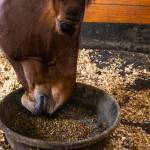Question
I have several Standardbred racehorses that have been diagnosed with ulcers based on stomach-scoping. Most are young—two or three years old—but there are a few older ones, too. The horses are in OK body condition, but they need to gain weight. Like most racehorses, they’re stalled except when working. They are fed a custom feed mixed for us by the local mill. The feed includes corn. The vet told us that we should not feed corn. I wonder if the corn could be causing the ulcers. Is there a feed on the market that prevents ulcers?
Answer
Racehorses in active training experience several factors associated with the onset of gastric ulcers, including stress, limited turnout on pasture, and large grain meals. Because of this, gastric ulcers are routinely diagnosed in racehorses of all types.
Feeding corn is not necessarily the cause of gastric ulcers, but feeding high-starch grains such as corn has been identified as a risk factor for ulcers. Starch is the predominant energy source in corn. While starch is required by racehorses for optimal performance, large amounts in the diet can have a negative impact on the health and function of the digestive tract.
Oats, corn, and barley are the most commonly used energy sources in horse feeds. Corn and barley require additional heat processing to improve starch digestibility in the small intestine. Processing these grains helps prevent undigested starch from entering the hindgut. Heat processing of oats is unnecessary.
The amount of starch fed at one time and over the course of the day is as important as the starch source. Research studies suggest that limiting starch intake to 1-2 g/kg body weight/meal is best to minimize digestive upset. What does that mean for the horse owner? If feeding a commercial race feed with 35-40% starch, for example, then no more than 4.4-5 lb (2-2.24 kg) of feed should be fed in a single meal. Keeping meal size small will help prevent starch overload and subclinical hindgut acidosis.
In addition to the grain or concentrate portion of the diet, it is important to assess and modify the forage program for optimal health and performance. Horses with high energy needs receive large amounts of concentrate feed to meet these needs, but this results in reduced forage intakes. Low forage intake is also a significant cause of digestive issues both in the stomach and hindgut of the horse. Offering racehorses free-choice access to good-quality forage is important. Selecting an early-maturity grass hay or a grass-legume mix can help maximize caloric intake while meeting the horse’s fiber requirements.
Another key management strategy is to not work horses on an empty stomach. Offering hay or a small concentrate meal prior to exercise is recommended, as this will fill the stomach and reduce acid contact with the delicate stomach lining. Providing a digestive buffer in this meal provides an additional layer of protection. For best results, feed this meal one to two hours prior to exercise.
KER offers advanced digestive health products that contain superior buffering ingredients and research-proven value, including EquiShure, RiteTrac, and Triacton. These products can be used in conjunction with ulcer medications and as a daily supplement. For young horses, I recommend adding Triacton, as it provides digestive buffering in addition to bone-building nutrients. Read the research on Triacton in Thoroughbred racehorses.
Racehorses are also prone to subclinical hindgut acidosis. For horses displaying signs of digestive discomfort despite ulcer medication treatment, EquiShure is the go-to product. EquiShure can offer immediate and long-term relief from hindgut acidosis, as the time-released coating ensures delivery of an active buffer to the cecum and large intestine.
Corn-free feeds are available to horse owners, but these are not necessarily the best feeds for high-performance horses. Selecting a feed that uses a combination of cereal grains (oats, corn, barley) that have been appropriately processed and blended with high-quality fat and fiber sources is the way to go.








